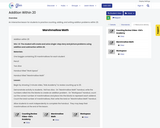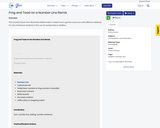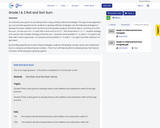
Solving Contextual Problems: Adding and Subtracting Decimals Mathematics Instructional Plan
- Subject:
- Mathematics
- Material Type:
- Lesson Plan
- Provider:
- VDOE
- Author:
- VDOE
- Date Added:
- 10/07/2024

Solving Contextual Problems: Adding and Subtracting Decimals Mathematics Instructional Plan

Solving practical problems using the four basic operations with whole numbers - Mathematics Instructional Plan

Operations with Integers Addition Algebra Readiness Remediation Plan

Students will analyze a provided math problem with an incorrect answer (bug). Students will demonstrate their understanding of the process by identifying the error, solving the problem correctly and providing an explanation. Math problem solving directly correlates with the step by step process that computer science debugging requires. The purpose of this experience is to provide a jumping off point for a deeper understanding of the Computer Science SOLs. This could be the first time your students are exposed to the vocabulary (algorithm, bug, debugging) and can provide a good foundation of the understanding of the vocabulary in a concrete, low-technology way.

This video is part of the Learn and Grow with WHRO TV series. Watch Nicole Neice teach about addition.

Adding and subtracting fractions using context as a tool to support student understanding Mathematics Instructional Plans (MIPs) help teachers align instruction with the 2016 Mathematics Standards of Learning (SOL) by providing examples of how the knowledge, skills and processes found in the SOL and curriculum framework can be presented to students in the classroom.

These Google Slides are intended to model how to use a Ten Frame when adding to 10.

An interactive lesson for students to practice counting, adding, and writing additon problems within 20.

This video is part of the Continue to Know with WHRO TV series. Watch Emily Rathbone teach about comprehending word problems using whole numbers.

This video is part of the Learn and Grow with WHRO TV series. Watch Xenia Claire teach about adding and subtracting with practical problems using a variety of strategies.

Adding and subtracting decimals, through the thousandths, used in contextual situations. Mathematics Instructional Plans (MIPs) help teachers align instruction with the 2016 Mathematics Standards of Learning (SOL) by providing examples of how the knowledge, skills and processes found in the SOL and curriculum framework can be presented to students in the classroom.

This resource is a remix from Illustrative Mathematics.This encourages student collaboration and allows students to have a mathematical dialogue to express their understanding of algebraic properties. This resource is a valuable part of building background when introducing units of measure or equations in the early elementary years of mathematics education as it provides students a concrete example of building an equation with concrete objects. Suggested Modification- Encourage student online portfolio - A student recording sheet with dominos illustrations can be used as a reference for students to have a mathematical dialogue. Teachers can use online educational platforms that would allow students to record their own understanding of math and share them with the teacher. For example, Seasaw is an educational platform that students can use, but will require parental permission. It allows collaboration between teachers, students, and the parent community where students can have a voice and choice in their learning.

This video is part of the Learn and Grow with WHRO TV series. Watch Shantel Davis teach addition and subtraction strategies.

The student will create & solve single-step story and picture problems using addition and subtraction

This video is part of the Continue to Know with WHRO TV series. Watch Emily Rathbone teach about estimating and solving multistep word problems using whole numbers.

Adding and subtracting fractions and mixed numbers Mathematics Instructional Plans (MIPs) help teachers align instruction with the Mathematics Standards of Learning (SOL) by providing examples of how the knowledge, skills and processes found in the SOL and curriculum framework can be presented to students in the classroom.

Estimating and adding to find sums for fractions and mixed numbers with like and unlike denominators. Mathematics Instructional Plans (MIPs) help teachers align instruction with the Mathematics Standards of Learning (SOL) by providing examples of how the knowledge, skills and processes found in the SOL and curriculum framework can be presented to students in the classroom.

Fraction Strips to Number Sentences: Adding Fractions Mathematics Instructional Plan

This remixed lesson from Illustrative Mathematics models how to get the same sum with different addends. It is also introduces students to the use of number lines in addition. https://goopenva.org/courses/2-md-frog-and-toad-on-the-number-line

As a teacher your goal is to provide practice using carefully selected strategies. Through encouragement you can provide experiences for students to develop efficient strategies. Use the following strategies to develop the basic addition facts. By the end of first grade, students should be able to counting on to find the sum. For the sum of 4 + 3, start with 4 and count on 5, 6, 7. This shows that 4 + 3 = 7. Another strategy is to use the near doubles strategy to find the sum. Using the same problem 3 + 4, add 3 + 3 to get 6 and then add 1 more to get seven. Or using the same problem 4 + 3, add 4 + 4 to get 8 and then subtract 1 to get seven.By providing experiences to learn these strategies, students will develop number sense and understand how to compose and decompose numbers. This in turn will help students to develop basic fact fluency and learn while having fun playing a game.